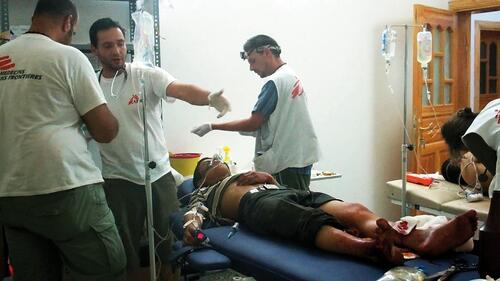How did you manage to set up this emergency mission without official authorisation from the Syrian authorities?
Surgical specialist Anna Nowak has completed more than 20 missions with Médecins Sans Frontières (MSF). She has just returned from Syria, where she helped to set up the project.
With the support of a group of Syrian doctors, we were able to identify a location to perform operations. After an initial brief visit, we decided on an empty villa. The two-storey, eight-room house was still under construction, but we didn’t have any other choice. For six days, we worked like crazy to transform the place into a surgical hospital with a dozen hospital beds, a sterilisation room, an operating theatre, a resuscitation room for emergencies and a recovery room. In addition to the difficulties involved in recruiting medical staff locally, we also had to solve supply problems, knowing that it’s risky right now to import or to buy medical supplies in Syria.
In what kind of conditions did you start operating on people?
The first patients arrived on 22 June, the day after the hospital opened. At first, we admitted mostly injured people who had already undergone surgery. Unfortunately, we had to do this under poor hygienic conditions, which generally means a higher risk of infection. As new conflicts broke out, the hospital quickly reached its limits. After a few days, we were getting up to six injured people at a time, a relatively modest number but still high considering our resources and treatment capacity. Then, injured people started coming from everywhere. We had to come up with other ways of accommodating people, even if it meant putting beds on the terrace. Sometimes the wounded didn’t arrive during the day because of fighting, because the roads were blocked or because travelling to the hospital was risky. Sometimes they came at night or at dawn. It was tiring, even though we could count on the help of the patients’ caretakers. The openness and willingness of these people to help out was really touching.
What kinds of injuries have you been seeing?
We’ve largely been seeing people wounded by bullets, mortar fire or shells. The most common injuries have been to people’s limbs, stomach area or between the neck and abdomen. Though most of the patients are men, women and children have also been arriving, and often too late. At the moment, there is fighting and bombing about ten kilometres from our facility. But our patients sometimes came from far away, risking their injuries becoming worse or even death. This makes you wonder about what hurdles stand in the way of getting quality care in Syria today, including for people whose wounds are not conflict-related, such as people injured in road accidents.
What are the main difficulties involved in such an intervention?
To limit the risks, hospital staff in Syria are working in a discrete and cautious manner, and many of the field hospitals disappear as quickly as they appear. In this context, the existence of a facility like ours is very important for injured people who need assistance, but it is also a very delicate situation. Security constraints limit our resources and capacity. A typical war wound requires an average of five days of hospitalisation. With the exception of the most serious cases, we sometimes have difficulties keeping patients in hospital longer than this. Patients who live close to the hospital or who are staying with family and friends nearby can come back for checkups or to get a dressing. But even though there’s lots of solidarity among the people here and lots of patients are able to stay in the area temporarily, some leave the hospital and we never hear from them again.



